AI Sprawl in the Workplace: How to Regain Control and Improve Productivity

Sorry, there were no results found for “”
Sorry, there were no results found for “”
Sorry, there were no results found for “”

Welcome to the era of AI sprawl.
In the race to stay ahead, organizations have thrown open the doors to every AI tool under the sun. The result? AI overload.
According to the Wharton School, AI spending has skyrocketed by 130% in just the past year, and 72% of companies are planning to invest even more in 2025.
Yet, here’s the kicker: 80% of organizations report no tangible enterprise-wide impact from their generative AI investments.
This is AI sprawl in action: a growing, costly problem that’s quietly eating away at your team’s time, budget, and sanity.
Let’s break down what AI sprawl really is, why it’s happening, and—most importantly—how you can get back in control.
AI Sprawl occurs when AI tools, models, and platforms spread chaotically across an organization—with no oversight, strategy, or idea of who’s using what. This leads to wasted money, duplicated efforts, security risks, and a total lack of control over your organization’s AI footprint.
Here’s what it looks like in practice: Your marketing is using one AI to generate campaign copy, Sales has another for lead scoring, HR is experimenting with a chatbot for onboarding, and IT is quietly running a dozen different AI-powered monitoring tools in the background.
❌ None of these systems talks to each other
❌ Data gets stuck in silos
❌ Context is lost
❌ Employees still spend more time switching between apps than actually getting work done
It’s not just a theoretical problem. In ClickUp’s recent AI Sprawl survey, nearly half of all workers said they have to bounce between two or more AI tools just to complete a single task.
But do not confuse AI sprawl with having “too much AI,” though!
The operative word here is disconnected workflows. Ultimately, having too many disconnected, overlapping, and underutilized AI tools creates more chaos than clarity.
AI sprawl doesn’t happen by accident.
It’s the natural outcome of a workplace where speed, autonomy, and a little bit of panic all collide.
After all, the barriers to entry are laughably low, and the urge to “just try that new tool” is hard to resist. Here’s what’s fueling the chaos:
👉🏽 Swipe-and-go adoption: Anyone can sign up for an AI tool with a credit card—no IT gatekeeping required. New apps slip into your stack faster than you can say “free trial”
👉🏽 Siloed problem-solving: Each team hunts for its own AI fix, rarely checking if another department already solved the same issue. The result? A patchwork of tools, none of which play nicely together
👉🏽 Missing governance: Without clear policies or standards, there’s no roadmap for which tools to use, how to share data, or who’s in charge when something breaks
👉🏽 AI FOMO: The fear of falling behind is real. With every headline hyping the next AI breakthrough, leaders feel pressured to adopt whatever’s trending—even if it doesn’t fit
When these forces combine, you get a tech landscape that looks like Frankenstein’s monster.
Reality Check: A new MIT report from Project NANDA (The GenAI Divide) shows that 95% of companies trying to use generative AI are failing. Only 5% are seeing real results, like actual revenue growth.
Work sprawl and AI sprawl are like digital cousins—related, but each with its own quirks.
Both can quietly sabotage productivity, but they do it in different ways. Understanding how they overlap (and amplify each other) is key to regaining control.
This is the classic productivity drain. It’s what happens when your team’s communication and workflows are scattered across a dozen apps—project management software, chat, docs, spreadsheets, and more.
Every tool promises to solve a problem, but together they create a maze of logins, notifications, and lost context.
What does that mean in terms of numbers? According to ClickUp’s State of Productivity Report, Teams juggling more than 15 tools are four times more likely to emerge as low-performing.
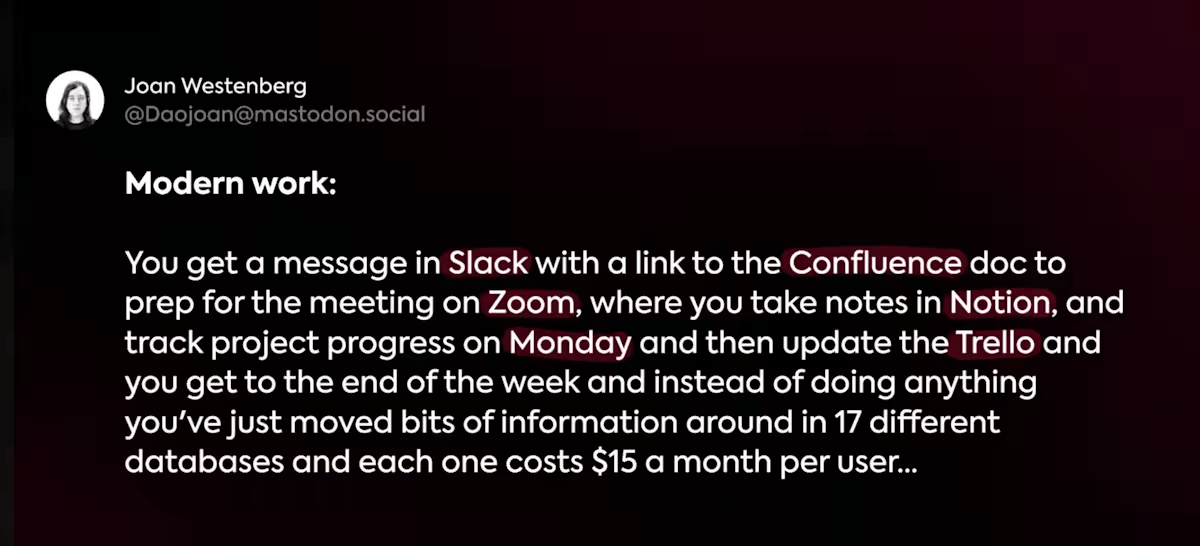
Now, add a layer of artificial intelligence to the mix.
Instead of one “smart” assistant, you’ve got a whole lineup: chatbots for customer service, AI writers for content, analytics bots for reporting, and specialized agents for everything from scheduling to sentiment analysis.
Each tool is powerful on its own, but none of them share context or data. The result? More silos, more confusion, and a growing sense that AI is just another thing to manage.
Work sprawl or SaaS Sprawl, in turn, sets the stage for AI sprawl.
When your digital workspace is already fragmented, it’s easy for teams to add new AI tools to solve specific pain points without considering integration or overlap.
Before you know it, you’re not just managing work across platforms; you’re also juggling a zoo of AI tools, each with its own learning curve.
Instead of simplifying work, you end up with more tabs, more passwords, and more time spent re-explaining context to machines that don’t remember what happened five minutes ago.
| 💼 Work sprawl | 🤖 AI sprawl | |
|---|---|---|
| What it is | A chaotic mess of tools, tasks, chats, and docs all over the place. | Too many AI tools deployed everywhere, with no coordination or strategy. |
| What causes it? | 🔹 Too many apps for everything 🔹 Disconnected workflows 🔹 Scattered knowledge | 🔹 Teams spinning up their own AI tools 🔹 No AI strategy 🔹 Vendor overload |
| What it feels like | 😫 Constant tab-switching 😵 Can’t find anything 🌀 Repeating work | 🤷 Who’s using what AI? 😬 Data risks hiding everywhere 💸 Costs stacking up |
| The hidden costs | 🕒 2.5+ hours/day lost to app hopping 📉 21% productivity drop 💰 Millions in wasted time | 📊 Redundant AI licenses 🔐 Compliance nightmares 🎯 Misdirected innovation⚡️ |
| Biggest tisks | ❌ Poor collaboration ❌ Slower decisions ❌ Low morale | ❌ Shadow AI use ❌ Data leaks ❌ Biased or unvalidated outputs |
The same thing that plagued SaaS is starting to plague AI. 😬
App sprawl is getting reincarnated as AI sprawl. A bunch of point solutions that either solve small, siloed problems. Or that don’t solve any real business problem at all.
This is a nightmare for employees. It’s too hard to understand which tool to use, and how best to use it.So the transformational power of AI never gets fully realized.
This is one of the main things we’re combating at ClickUp. A single app with all your work context – projects, chat, docs, process, knowledge, data. That allows you to create custom AI automations, workflows, and Agents. Standardizing how AI is used. And ensuring that it actually does.

📖 Read More: Best All-in-One Software Solutions for Businesses
AI sprawl can quickly become a full-blown organizational migraine.
What starts as a few “helpful” tools quickly snowballs into a labyrinth of apps, each demanding attention, budget, and brainpower.
The fallout is bigger than most leaders realize.
Every time an employee jumps from one AI tool to another, a little bit of focus evaporates.
In fact, 88% of people say that they use AI every day, and 55% use it several times a day.
Each switch to an AI tool means re-explaining context, reformatting data, and reconciling outputs—hardly the seamless automation we were promised. Instead of accelerating work, AI sprawl slows it to a crawl.

Here’s a harsh reality: Most of those shiny new AI subscriptions are gathering digital dust.
Despite companies investing in dozens of tools, 91% of workers stick to just 1-4 each week.
Even more telling, 44.8% of teams have already abandoned AI tools they adopted in the past year.
That’s time lost in implementation, wasted training resources, and a growing skepticism toward future AI initiatives.
AI is only as smart as the context it understands.
Yet, over a third of workers (34.4%) use AI tools that are not integrated with their core work—they do not have access to projects, documents, or conversations.
What does that breakdown look like? We found that 62% of people prefer to use conversational AI like ChatGPT or Claude to help them with tasks.
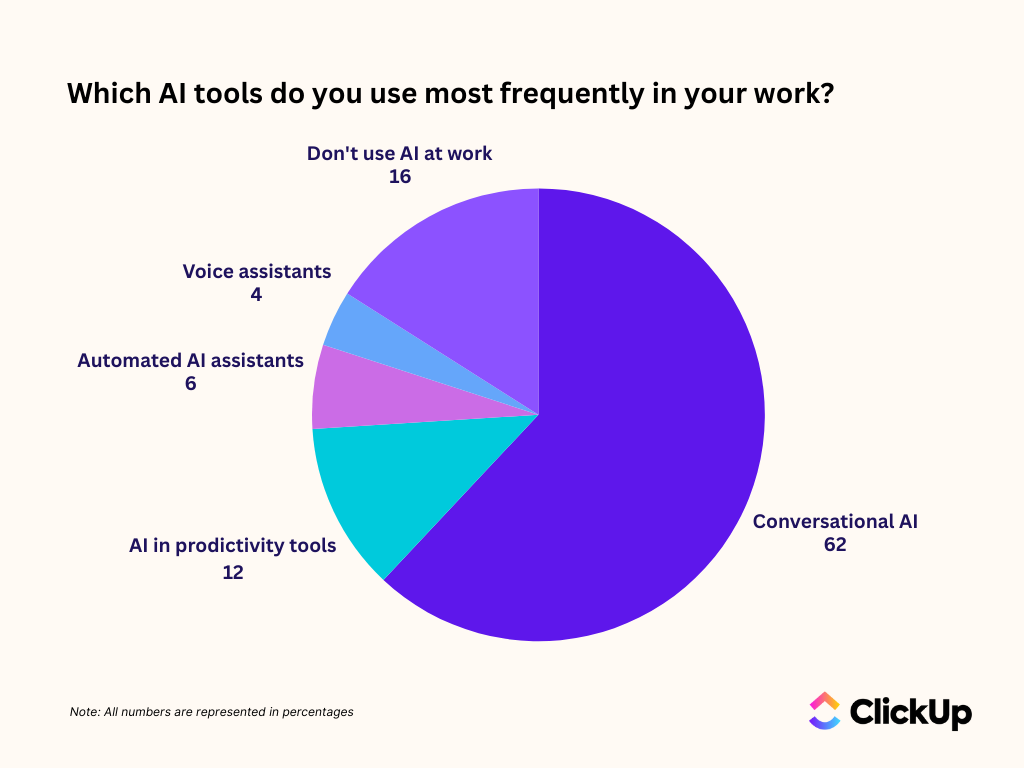
This means every prompt starts from square one, forcing users to manually provide background and explain terminology that already exists elsewhere.
👉🏽 This Redditor perfectly captures the frustrations with AI and its lack of context, and it resonated with people!
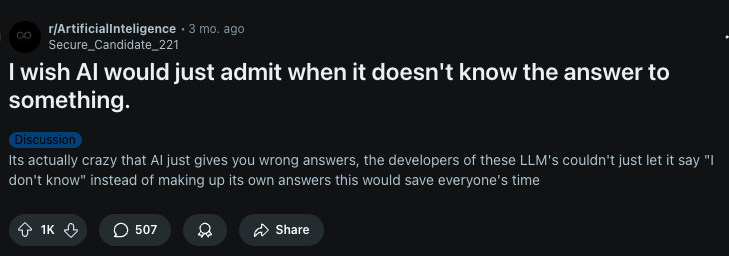
When every department picks its own AI flavor, teams end up solving the same problems in different ways.
Marketing’s chatbot doesn’t know what Sales’ lead scorer is doing, and HR’s onboarding assistant can’t pull data from IT’s analytics tool.
This patchwork approach leads to duplicated work, conflicting outputs, and a lack of organizational coherence.
📮ClickUp Insight: The average professional spends 30+ minutes a day searching for work-related information—that’s over 120 hours a year lost to digging through emails, Slack threads, and scattered files.
An intelligent AI assistant embedded in your workspace can change that. Enter ClickUp Brain. It delivers instant insights and answers by surfacing the right documents, conversations, and task details in seconds—so you can stop searching and start working.
💫 Real Results: Teams like QubicaAMF reclaimed 5+ hours weekly using ClickUp—that’s over 250 hours annually per person—by eliminating outdated knowledge management processes. Imagine what your team could create with an extra week of productivity every quarter!
The more tools in play, the harder it is to keep data safe.
Nearly 60% of employees admit to using unauthorized public AI tools for work tasks, often feeding sensitive company data into platforms with little oversight.
Accountability becomes a black hole—44% of organizations say no one is formally responsible for the consequences of bad AI output.
In another ClickUp survey, with over 30,000 participants, we asked users what’s holding them back from using AI more. Here’s what we found:
📍 28% are already using AI regularly
📍27% need more training for advanced use
📍23% aren’t sure where to start
📍11% worry about privacy
📍11% don’t fully trust AI
And let’s not forget the human cost.
Managing multiple projects across different interfaces, passwords, and workflows creates a mental tax that drains energy and morale.
Nearly 80% of workers say the effort required to prompt and manage AI feels disproportionate to the value they get in return.
Instead of empowering teams, AI sprawl leaves employees overloaded, exhausted, and even disengaged.
The bottom line: AI sprawl signifies lost productivity, increased risk, and a workforce that’s quietly losing faith in the promise of AI. The longer it goes unchecked, the more it undermines your ability to innovate, compete, and grow.
What people actually want AI to do!
We asked around, and here is what people said:
✅ 33% think that AI can help them grow their skills (learning, practicing, improving)
✅ 21% believe AI can help them crush it at work (meetings, emails, projects)
✅ 18% think AI can help them keep their life organized (calendar, tasks, reminders)
✅ 15% want AI to help them take care of the small things (routine tasks, admin work)
✅ 13% look to AI to help them tackle the tough stuff (decisions, problem-solving)
Good news? We just built that one AI app that can do all of this and more for you! Meet Brain MAX, your AI desktop companion that can do it all!
AI sprawl rarely arrives with a neon sign.
More often, it sneaks in quietly—one tool here, another subscription there—until suddenly, your team is buried under a pile of bots and project dashboards.
Here’s what to watch for:
🧨 Multiple AI tools for the same job: If you find three different chatbots answering customer questions—or worse, giving three different answers—you’re deep in sprawl territory
🧨 Employees can’t remember which AI does what: When team members start keeping a cheat sheet just to track which tool generates reports, summarizes meetings, or drafts emails, it’s time to hit pause
🧨 Frequent context re-entry: If your staff is constantly re-explaining the same project details to different AI tools, it’s costing your team in terms of time and patience
🧨 Shadow AI is on the rise: Employees quietly sign up for public AI tools without IT’s blessing, often to fill gaps left by official solutions. This not only fragments your stack but also opens the door to security risks
🧨 Inconsistent outputs and confusion: When different AIs spit out conflicting recommendations or data, decision-making slows to a crawl, and trust in AI erodes even further
🧨 Mounting subscription costs: If your finance team is surprised by the number of AI-related invoices each month, you’re likely paying for more tools than you need
How do you know when you’re juggling too many AI apps? This Redditor asks a valid question.

👉🏽 Learn More: How Much Toggle Tax Are You Paying?
AI sprawl doesn’t fix itself. It’s not just going to “settle down” after a while.
If you want to regain control—and actually see a return on your AI investments—you need a proactive, structured approach. Here’s how leading organizations are tackling the challenge:
Start with a full inventory.
List every AI tool in use, whether it’s officially sanctioned or quietly adopted by a single team.
But don’t just ask IT—survey department heads, scan expense reports, and check for shadow AI subscriptions. You can use a simple spreadsheet or a dedicated work management platform to track:
Why it matters: You can’t fix what you can’t see. As we’ve already seen, 44.8% of teams have abandoned AI tools in the past year—often because no one realized how many were in play or how little value they delivered.

Once you know what’s out there, it’s time to streamline.
The goal isn’t just fewer tools—it’s smarter, more connected tools. Here’s how:

AI without rules is a recipe for chaos—and risk. Establish clear governance to ensure your AI strategy delivers value, not headaches:
💡Pro Tip: Build secure practices in by design. Automate workflows for AI approval with ClickUp Automations and make AI-specific knowledge instantly available to anyone in the company via Agentic workflows.
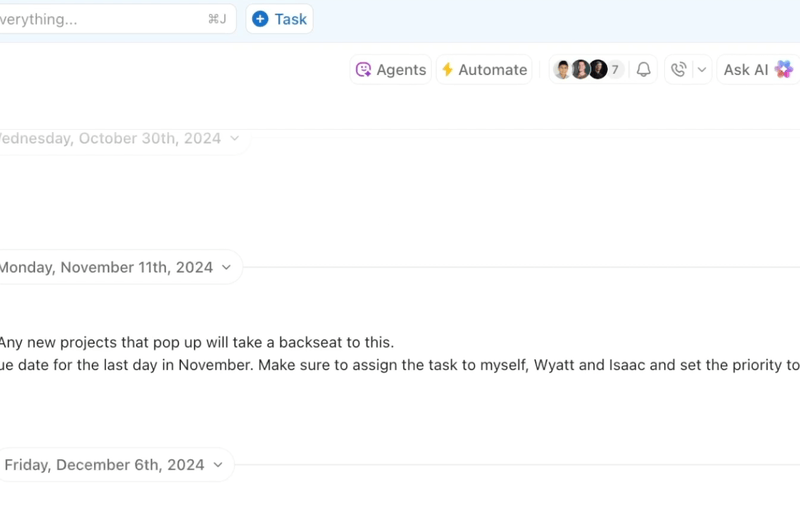
🧠 Did You Know? A ClickUp Survey found that 45% of workers have thought about using automation, but haven’t taken the leap. Factors like limited time, uncertainty about the best tools, and overwhelming choices can hold people back from taking the first step toward automation. See how you can use AI agents for automation!
The most effective way to eliminate AI tool sprawl?
Invest in a platform that brings AI into the flow of work—where it can generate, organize, and automate without forcing users to jump between apps.
Watch contextual AI in action.👇🏼
Managing AI sprawl is about more than cutting subscriptions. It requires you to build a connected, governed, and context-rich ecosystem where AI actually works for you—not the other way around.
Most AI tools are like talented freelancers—they do one thing well. But they don’t know your business, your projects, or your people.
Contextual AI is different.
It’s the in-house expert who understands your organization’s language, history, and goals. Instead of processing each prompt as a standalone, it connects the dots across every layer of your workflow.
Here’s what sets contextual AI apart:

Contextual AI is the intelligence layer running through your entire workspace.
Instead of toggling between a patchwork of bots and assistants, your team gets a single, unified experience—where AI generates, organizes, and automates work in context.
ClickUp’s AI-powered Project Management puts your work on autopilot, allowing you and your team to focus on the important stuff.
“At ClickUp, our mission has always been to save people time. AI tools are everywhere, but none are saving you time through every step of your work day. ClickUp Brain is deeply embedded in the place you do work; it bridges the gaps and connects the dots across your work, your communication, and your knowledge. ClickUp Brain is here to save you time and eliminate work about work.”

Contextual AI is built into every feature—tasks, docs, chat, dashboards, and reporting. ClickUp Brain is a perfect example of this.
That means:

ClickUp Brain is the antidote to AI tool sprawl. Instead of paying for a dozen disconnected AI subscriptions, you get:
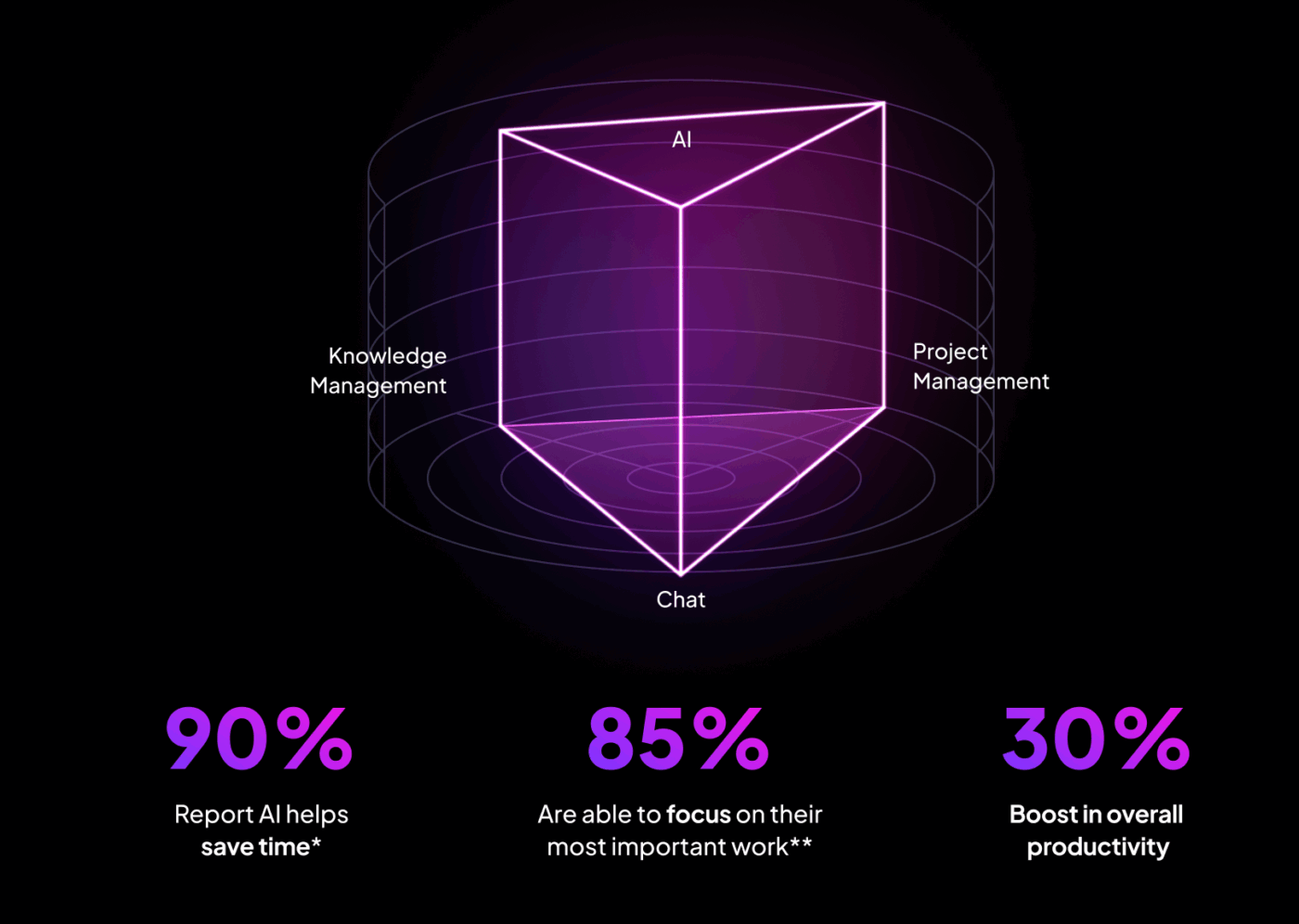
When your knowledge, projects, and collaboration tools are seamlessly connected, teams can finally experience the true promise of AI at work: execution at scale. The numbers speak for themselves:
AI sprawl is accelerating, whether we like it or not.
Here’s what the future holds, broken down into the key forces driving the problem:
| Key forces shaping AI Sprawl | Supporting data & insights | Projected impact |
|---|---|---|
| Skyrocketing AI usage | ➡️ ChatGPT has surged to ~800 million weekly active users, handling over 1 billion daily queries and receiving 4.5 billion website visits ➡️ Daily AI use among desktop workers rose 233% over six months; 3 in 5 use it daily, boosting productivity (+64%), focus (+58%), and job satisfaction (+81%) | ❗️With AI deeply embedded in enterprises and daily workflows, the proliferation of tools accelerates rather than slows. AI usage is becoming ubiquitous—there is no sign of retreat |
| Stacking over standardization | ➡️ 78% of users bring their own AI tools to work; 52% are reluctant to admit to using AI for key tasks | ❗️Tool proliferation is largely uncoordinated. Employee-driven adoption and secrecy fuel fragmented stacks—and cultural divides over openness and trust |
| Fragmentation intensifies | ➡️ 40%+ of cyber breaches by 2027 may stem from improper GenAI use, raising alarm around trust and security | ❗️The lack of a unified strategy amplifies fragmentation, increasing context loss, toggle-tax, and mounting security risks across decentralized environments |
| What’s next | ➡️ Based on the pattern of adoption vs ROI, the “J-curve” effect suggests value may be delayed but still achievable | ❗️Those that proactively build cohesive, secure, and context-rich AI frameworks can reverse sprawl and unlock sustainable advantage with AI |
AI sprawl is no longer a hypothetical—it’s the reality for modern teams.
But the future doesn’t belong to organizations with the most AI tools—it belongs to those with the smartest, most connected AI. That’s where ClickUp comes in.
ClickUp Brain offers a deeply integrated, context-aware intelligence layer that powers every aspect of your work—docs, tasks, chat, search, and automation—all in one place.
Instead of juggling a patchwork of bots and assistants, your team gets a single, unified platform that understands your business, adapts to your needs, and grows smarter with every interaction.
By consolidating your AI stack with ClickUp, you eliminate the toggle tax, reduce costs, and finally unlock the real promise of artificial intelligence: faster execution, smarter decisions, and a team that’s free to focus on what matters most!
✅ Sign up for ClickUp today and get the best of what AI has to offer.
AI sprawl refers to the uncontrolled proliferation of artificial intelligence tools, models, and solutions across an organization, often without centralized oversight. SaaS sprawl, on the other hand, is the unchecked growth of software-as-a-service applications. While both involve decentralized adoption and management, AI sprawl specifically deals with AI technologies, which can introduce unique risks such as data privacy, model bias, and regulatory compliance, in addition to the typical challenges of SaaS sprawl like cost, security, and integration issues.
AI sprawl can lead to:
Shadow AI refers to the use or development of AI tools and models by employees or departments without the knowledge or approval of IT or governance teams. It is a major driver of AI sprawl, as these unsanctioned solutions contribute to the uncontrolled spread of AI technologies, increasing risks around security, compliance, and resource allocation.
The cost of AI sprawl can be measured by:
Governance establishes policies, standards, and oversight for AI adoption and usage. Effective governance:
© 2025 ClickUp